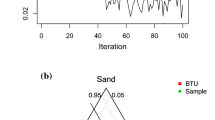Abstract
Unlike other data intensive domains, understanding distributions, trends, correlations, and relationships in materials data sets typically involves navigating high-dimensional spaces with only a limited number of observations. Under these conditions extracting structure/property relationships is not straightforward and considerable attention must be given to the reduction of feature space before predictions can be made. Here we have used Kohonen networks (self-organizing maps) to identify hidden structure/property relationships in computational sets of twinned and single-crystal diamond nanoparticles based on structural similarity in multiple dimensions, and confirmed the importance of a limited number of surface chemical features using regression.




Similar content being viewed by others
References
A. Agrawal and A. Choudhary: Perspective: materials informatics and big data: realization of the fourth paradigm of science in materials science. APL Mater. 4, 053208 (2016).
A. Jain, G. Hautier, S.P. Ong, and K. Persson: New opportunities for materials informatics: resources and data mining techniques for uncovering hidden relationships. J. Mater. Res. 31, 977 (2016).
B. Sun, M. Fernandez, and A.S. Barnard: Statistics, damned statistics and nanoscience–using data science to meet the challenge of nanomaterial complexity. Nano Horiz. 1, 89 (2016).
Ramprasad R, Batra R, Pilania G, Mannodi-Kanakkithodi A, and Kim C: Machine learning in materials informatics: recent applications and prospects. Comput. Mater. 3, 54 (2017).
R. Ramakrishnan and A. von Lilienfeld: Machine learning, quantum chemistry, and chemical space. Rev. Comput. Chem. 30, 225 (2017).
B. Sun, M. Fernandez and A.S. Barnard: Machine learning for silver nano-particle electron transfer property prediction. J. Chem. Info. Mod. 57, 2413 (2017).
L. Ward and C. Wolverton: Atomistic calculations and materials informatics: a review. Curr. Opin. Solid State Mater. Sci.,> 21, 167 (2017).
E. Swann, B. Sun, D.M. Cleland, and A.S. Barnard: Representing molecular and materials data for unsupervised machine learning. Molec. Simulat. 44, 905 (2018).
T. Kohonen: The self-organizing map. Neurocomputing 21, 1 (1998).
C. Bishop: Neural Networks for Pattern Recognition (Oxford University Press, USA, 1995).
J. Gasteiger, X. X. Li, C. Rudolph, J. Sadowski, and J. Zupan: Representation of molecular electrostatic potentials by topological feature maps. J. Am. Chem. Soc. 116, 46084 (1994).
B. Sun and A.S. Barnard: Texture based image classification for nanopar-ticle surface characterisation and machine learning. J. Phys.: Mater. 1, 016001 (2018).
P. Wittek, S.C. Gao, I.S. Lim, and L. Zhao: An efficient parallel library for self-organizing maps. J. Stat. Software,> 78, 1 (2017).
A. Barnard: Nanodiamond Data Set, v1. CSIRO Data Collection (2016) doi: 10.4225/08/571F076D050B1.
A. Barnard: Twinned Nanodiamond Data Set, v2. CSIRO Data Collection (2018) doi: 10.25919/5be375f444e69.
B. Sun and A.S. Barnard: Impact of speciation on the electron charge transfer properties of nanodiamond drug carriers. Nanoscale 8, 14264 (2016).
S. Osswald, G. Yushin, V. Mochalin, S. O. Kucheyev, and Y. Gogotsi: Control of sp2/sp3 carbon ratio and surface chemistry of nanodiamond powders by selective oxidation in air. J. Am. Chem. Soc. 128, 11635 (2006).
L. Ginés, S. Mandal, A. Ahmed, C.-L. Cheng, M. Sow, and O.A. Williams: Positive zeta potential of nanodiamonds. Nanoscale 9, 12549 (2017).
T. K. Ho: Random Decision Forests. In Proceedings of the 3rd International Conference on Document Analysis and Recognition, Montreal, QC, pp. 278 (1995).
O.A. Williams, J. Hees, C. Dieker, W. Jäger, L. Kirste, and C.E. Nebel: Size-Dependent reactivity of diamond nanoparticles. ACS Nano 4, 4824 (2010).
A. Nagl, S. R. Hemelaar, and R. Schirhagl: Improving surface and defect center chemistry of fluorescent nanodiamonds for imaging purposes—a review. Anal Bioanal. Chem. 407, 7521 (2015).
K. Turcheniuk and V. Mochalin: Biomedical applications of nanodiamond (Review). Nanotechnology 28, 252001 (2017).
A.S. Barnard: Predicting the impact of structural diversity on the performance of nanodiamond drug carriers. Nanoscale 10, 8893 (2018).
S. Stehlik, L. Ondic, A.M. Berhane, I. Aharonovich, H.A. Girard, J.-C. Arnault, and B. Rezek: Photoluminescence of nanodiamonds influenced by charge transfer from silicon and metal substrates. Diamond Relat. Mater. 63, 91 (2016).
Author information
Authors and Affiliations
Corresponding author
Supplementary material
The supplementary material for this article can be found at https://doi.org/10.1557/mrc.2019.36
Supplementary Information
Rights and permissions
About this article
Cite this article
Barnard, A.S., Motevalli, B. & Sun, B. Identifying hidden high-dimensional structure/property relationships using self-organizing maps. MRS Communications 9, 730–736 (2019). https://doi.org/10.1557/mrc.2019.36
Received:
Accepted:
Published:
Issue Date:
DOI: https://doi.org/10.1557/mrc.2019.36




